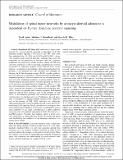Files in this item
Modulation of spinal motor networks by astrocyte-derived adenosine is dependent on D1-like dopamine receptor signalling
Item metadata
| dc.contributor.author | Acton, David | |
| dc.contributor.author | Broadhead, Matthew J. | |
| dc.contributor.author | Miles, Gareth B. | |
| dc.date.accessioned | 2018-08-31T16:30:05Z | |
| dc.date.available | 2018-08-31T16:30:05Z | |
| dc.date.issued | 2018-09-01 | |
| dc.identifier | 253136993 | |
| dc.identifier | 02bc987f-e788-4149-bad4-bee4870928be | |
| dc.identifier | 85052661373 | |
| dc.identifier | 000444097100012 | |
| dc.identifier.citation | Acton , D , Broadhead , M J & Miles , G B 2018 , ' Modulation of spinal motor networks by astrocyte-derived adenosine is dependent on D 1 -like dopamine receptor signalling ' , Journal of Neurophysiology , vol. 120 , no. 3 , pp. 998-1009 . https://doi.org/10.1152/jn.00783.2017 | en |
| dc.identifier.issn | 0022-3077 | |
| dc.identifier.other | ORCID: /0000-0002-8624-4625/work/45160474 | |
| dc.identifier.uri | https://hdl.handle.net/10023/15929 | |
| dc.description | D.A. was supported by funds from a Wellcome Trust Institutional Strategic Support Fund grant. G.B.M. and M.J.B. received support from Biotechnology and Biological Science Research Grant BB/M021793/1. | en |
| dc.description.abstract | Astrocytes modulate many neuronal networks, including spinal networks responsible for the generation of locomotor behavior. Astrocytic modulation of spinal motor circuits involves release of ATP from astrocytes, hydrolysis of ATP to adenosine, and subsequent activation of neuronal A1 adenosine receptors (A1Rs). The net effect of this pathway is a reduction in the frequency of locomotor-related activity. Recently, it was proposed that A1Rs modulate burst frequency by blocking the D1-like dopamine receptor (D1LR) signaling pathway; however, adenosine also modulates ventral horn circuits by dopamine-independent pathways. Here, we demonstrate that adenosine produced upon astrocytic stimulation modulates locomotor-related activity by counteracting the excitatory effects of D1LR signaling and does not act by previously described dopamine-independent pathways. In spinal cord preparations from postnatal mice, a D1LR agonist, SKF 38393, increased the frequency of locomotor-related bursting induced by 5-hydroxytryptamine and N-methyl-d-aspartate. Bath-applied adenosine reduced burst frequency only in the presence of SKF 38393, as did adenosine produced after activation of protease-activated receptor-1 to stimulate astrocytes. Furthermore, the A1R antagonist 8-cyclopentyl-1,3-dipropylxanthine enhanced burst frequency only in the presence of SKF 38393, indicating that endogenous adenosine produced by astrocytes during network activity also acts by modulating D1LR signaling. Finally, modulation of bursting by adenosine released upon stimulation of astrocytes was blocked by protein kinase inhibitor-(14–22) amide, a protein kinase A (PKA) inhibitor, consistent with A1R-mediated antagonism of the D1LR/adenylyl cyclase/PKA pathway. Together, these findings support a novel, astrocytic mechanism of metamodulation within the mammalian spinal cord, highlighting the complexity of the molecular interactions that specify motor output. | |
| dc.format.extent | 13262374 | |
| dc.language.iso | eng | |
| dc.relation.ispartof | Journal of Neurophysiology | en |
| dc.subject | Neuromodulation | en |
| dc.subject | Metamodulation | en |
| dc.subject | Gliotransmission | en |
| dc.subject | Central pattern generator | en |
| dc.subject | CPG | en |
| dc.subject | Motor control | en |
| dc.subject | PAR1 | en |
| dc.subject | BF Psychology | en |
| dc.subject | QP Physiology | en |
| dc.subject | RC0321 Neuroscience. Biological psychiatry. Neuropsychiatry | en |
| dc.subject | NDAS | en |
| dc.subject.lcc | BF | en |
| dc.subject.lcc | QP | en |
| dc.subject.lcc | RC0321 | en |
| dc.title | Modulation of spinal motor networks by astrocyte-derived adenosine is dependent on D1-like dopamine receptor signalling | en |
| dc.type | Journal article | en |
| dc.contributor.sponsor | The Wellcome Trust | en |
| dc.contributor.sponsor | BBSRC | en |
| dc.contributor.institution | University of St Andrews. School of Psychology and Neuroscience | en |
| dc.contributor.institution | University of St Andrews. Institute of Behavioural and Neural Sciences | en |
| dc.identifier.doi | 10.1152/jn.00783.2017 | |
| dc.description.status | Peer reviewed | en |
| dc.date.embargoedUntil | 2018-08-29 | |
| dc.identifier.url | https://europepmc.org/abstract/MED/29790837 | en |
| dc.identifier.grantnumber | en | |
| dc.identifier.grantnumber | BB/M021793/1 | en |
This item appears in the following Collection(s)
Items in the St Andrews Research Repository are protected by copyright, with all rights reserved, unless otherwise indicated.

